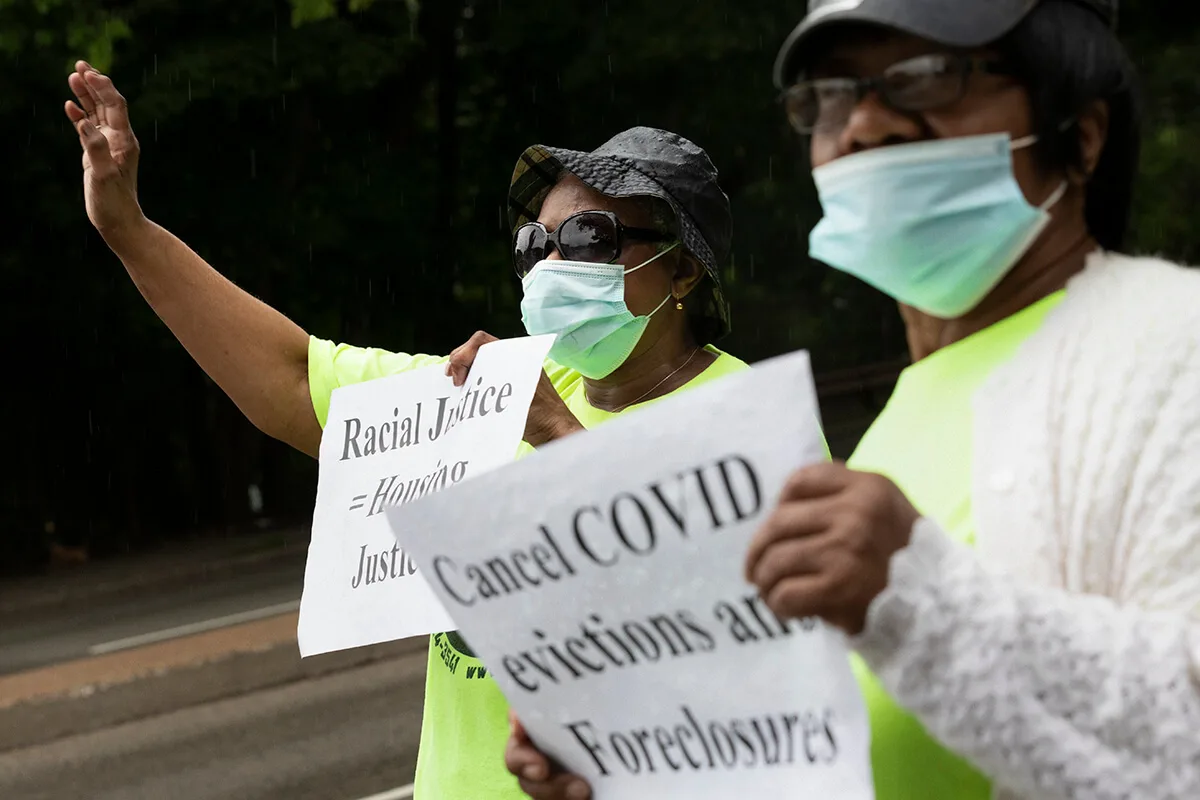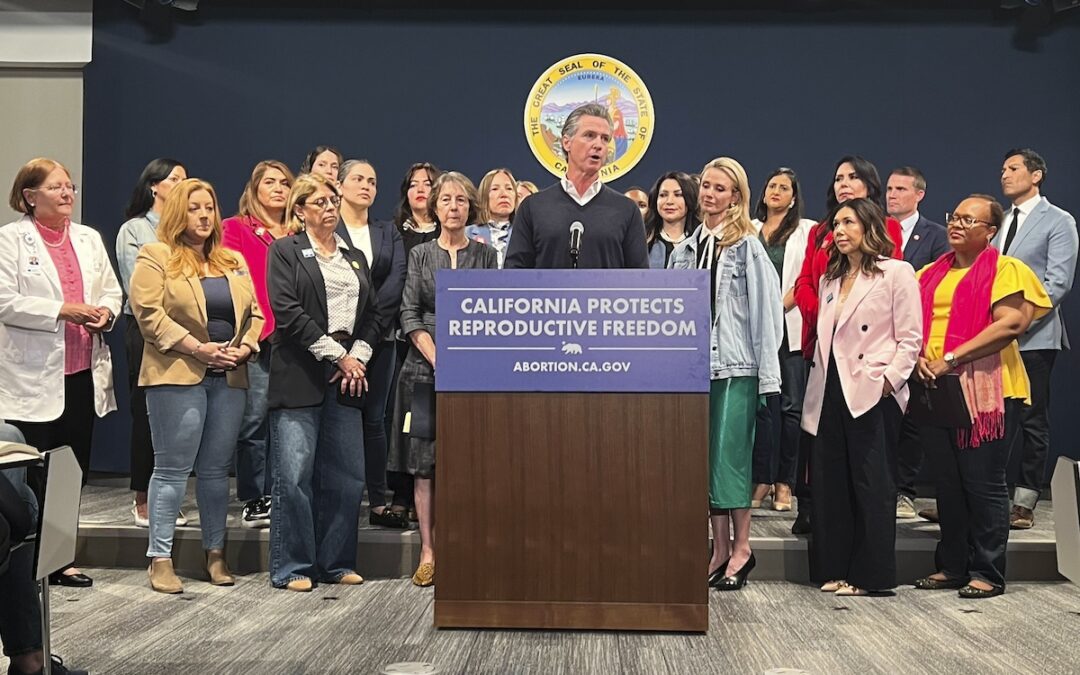
Annie Gordon, left, and Jenny Clark, rally for protection from evictions Saturday, June 27, 2020, in the Mattapan neighborhood of Boston. Massachusetts' tenant eviction moratorium is slated to expire in mid-August. (AP Photo/Michael Dwyer)
Protections for renters during the pandemic are running out right as federal unemployment payments are set to expire.
Two major protections for Arizona tenants who are struggling to keep up with rent during the pandemic are ending this month, potentially leaving thousands of people without shelter in the summer heat.
Gov. Doug Ducey issued an executive order in March that allows eviction proceedings to continue but bars constables from enforcing them if tenants have been negatively impacted by the virus, physically or financially. The moratorium on evictions ends July 22.
Federal protections established under the Coronavirus Aid, Relief, and Economic Security (CARES) Act, are set to expire on July 26. Since the CARES Act was passed in March, certain landlords have been barred from initiating evictions. Justice of the Peace Anna Huberman of the Country Meadows Court said this applies to about 30% of the properties in Maricopa County.
By the end of July, tenants who have already been issued an eviction will be forced to leave, while a new onslaught of eviction proceedings that has been on hold could begin.
A Frenzy in the Courts
Huberman said it’s difficult to predict what the end of this month will look like.
“We’re definitely concerned about what’s coming,” she told The Copper Courier. “We’re aware of the challenges the courts are going to face because of all of this.”
Huberman said her court, which represents 8-10% of the county, had just over 50 evictions that hasn’t been carried out yet due the state’s delay on enforcement. Their normal case load has also been below average.
RELATED: Rent, Unemployment Insurance, and Other Important COVID-19 Deadlines: What You Need To Know In AZ
According to The Arizona Republic, just courts in the state issued more than 1,500 eviction orders in May 2019. This year, there were only 578.
“I don’t know if that means that the landlords haven’t been filing the eviction actions because they are actually working with the tenants,” she said, “or because they know that the tenant was going to get the reprieve anyways so they just didn’t bother filing yet.”
A landlord group told The Republic it estimates as many as 5,000 eviction cases could be filed in the state following the protection’s expiration.
So far, about 2,000 evictions have already been processed in Maricopa and Pima counties during the pandemic, meaning thousands of people are at risk of losing stable housing come July 23.
Not Enough Help
Despite the protections in place delaying evictions, tenants have still been expected to pay their rent each month.
But many have reported having difficulty accessing resources designed to help people affected by job or loss or other pandemic-related setbacks.
The state has a pot of $5 million for assistance, which can give people in need up to $2,000 for rent per month.
But according to the Arizona Department of Housing (ADOH), 47% of the nearly 17,000 applications it has received for rental assistance are still in review.
Of those that have been decided, only 12% were approved for funding, while 76% were incomplete, 7% were withdrawn, and 5% were ineligible.
Huberman said she has heard tenants say during hearings they have had difficulty reaching the agencies like ADOH as well as the state’s Department of Economic Security (DES) for unemployment benefits. Some also waited months for their $1,200 stimulus checks.
“‘I lost my job, I haven’t been working, I had to stay home because my kids were no longer in school.’ It was just these stories [in hearings] over and over again,” Huberman said.
RELATED: Gov. Ducey Promised Rental Eviction Help But Few Arizona Renters Are Actually Seeing It
Pam Bridge, an attorney with Community Legal Services, said her office has been inundated with calls from people asking for help.
“We definitely have heard people not hearing back and having a difficult time accessing those funds,” she told The Copper Courier.
But Bridge is hopeful things will speed up soon – ADOH has made several changes in an effort to get more people money.
“I am hopeful that we are going to come up with ways that tenants can access faster rent assistance,” Bridge said.
ADOH spokeswoman Janelle Johnsen said recent changes including the opening of a new call center to field applicants’ questions and reductions to the number of documents needed to prove eligibility.
ADOH also reversed a policy that ruled some applicants ineligible based on their savings.
Relief could also come faster from other places, as Phoenix, Mesa, and Maricopa County received funds from the CARES Act they have set aside for assisting residents with rent and utilities.
But due to Ducey’s funding allocation, smaller cities have less flexibility to offer their residents help. The governor held back $395 million that the federal government recommended go to municipalities, instead putting the money into the state’s general fund.
To check for other assistance options, people can enter their information into the Arizona Community Action Network’s Self Help tool, which helps determine what programs a person is eligible for.
Possibility of Extending Safeguards
Despite the difficulty Arizonans have experienced obtaining assistance, Ducey hasn’t acknowledged the crisis many people are facing. Instead, he has reiterated that safeguards are on the books.
“Protections are in place. And we’re looking at this in the totality of where we are as a state, what’s happening with the federal and state packages,” Ducey said at a briefing Monday.
“We don’t want to see anyone fall through the social safety net,” he added. “And I would think our actions to date to stretch it and strengthen it should be evidence on how we want to protect Arizonans — and we’re getting better.”
Despite calls to extend the enforcement delay on evictions, Ducey hasn’t signaled any intent to do so.
His spokesman told The Arizona Republic the end date remains in place, and that Ducey is focused on determining “any additional actions that may be needed following the order’s expiration.”
A group of 33 Democratic state lawmakers sent a letter to the governor, asking him to push back the end date by six months.
“We can and must do more to prevent the pending crisis of potentially thousands of families unable to pay back rent,” the lawmakers wrote. “By extending your Executive Order by six months, until January 22, 2021, you will protect families and their children from homelessness and protect members of the public from the further spread of the disease occasioned by widespread evictions.”
Another Blow to Income
Another obstacle in tenants’ way is Arizona’s low unemployment payouts. The state only provides up to $240 per week for people who have lost their jobs.
The federal government added an additional weekly $600 with the CARES Act, but that boost will run out July 31 if Congress doesn’t vote to extend it.
While Sen. Kyrsten Sinema (D-Ariz.) has said she would support an extension, Sen. Martha McSally (R-Ariz.) has gone back and forth on the issue.
Senate Majority Leader Mitch McConnell, whom McSally often sides with, has vowed to keep an extension out of the next relief bill because he believes the extra relief is disincentivizing work.
On Thursday, President Donald Trump celebrated last month’s job gains, saying the U.S. economy was “roaring back.”
However, those numbers did not include Arizona and other state’s recent actions to once again close certain businesses while case numbers rise.
RELATED: McSally Is Now Praising the Very Unemployment Benefits She Voted Against
Ducey announced a new round of closures Monday that affects bars, nightclubs, gyms, movie theaters, waterparks, and tubing to try to curb the state’s COVID-19 resurgence.
People in those industries won’t be able to return to work until at least July 28.
Many others remain out of work due to businesses permanently closing down, or an inability to leave home due to medical and caregiving reasons.
More than 22 million people in the U.S. lost their jobs in March and April. Despite some of those coming back, the market still faces a net loss of 14.7 million jobs.
And despite Trump saying he thinks the virus will “disappear,” many states are experiencing resurgences as the summer goes on, possibly resulting in the need to return to stay-at-home orders and more businesses closing once again.
An Extra Stressful Time
Tenants who are kicked out of their homes at the end of the month will face many challenges beyond the obvious, Bridge said.
For one, they have extra urgency to find shelter and more difficulty moving possessions in the summer heat.
Another concern is that visiting properties and meeting with staff increases risk of being exposed to COVID-19.
RELATED: These Top Scientists Are Now Saying It’s Time For Another Stay-at-Home Order In Arizona
“[Tenants] don’t want to be kicked out and looking for property right now when we’re being told to stay at home,” Bridge said.
And, with the school year coming up fast, Bridge said many children’s enrollment may be up in the air.
“Families with children are going to have to enroll within like a week … if they’re able to find another place,” she said.
Ducey also on Monday pushed back the beginning date of in-person classes to Aug. 17, but distance learning can begin two weeks earlier, meaning many families will need to secure access to internet and computers soon.
Left Without Options
For many Arizonans, a lack of affordable housing options is nothing new.
“Before this [pandemic] even started, we had an eviction crisis in Phoenix,” Bridge said. “What our normal looked like was people not being able to afford rent in Phoenix.”
The city has seen rents rise by 7% over the past year, one of the fastest-growing average rents in the country.
A worker in Arizona’s capital must earn nearly $20 an hour to afford an average two-bedroom apartment, according to the National Low Income Housing Coalition. The nonprofit says the average Arizona renter now earns about $17 an hour. The state’s minimum wage was raised this year to $12.
RELATED: Coronavirus Is Exposing Why the Affordable Housing Crisis Is Also a Healthcare Crisis
Huberman said she already considered the number of evictions her court processed “a dire situation” before people were laid off in record numbers this spring.
She said landlords often report to their networks when they have evicted a tenant, meaning the judgment can make it difficult for tenants to find a new home.
But she said she hopes landlords will factor in the timing of a person’s record when processing applications, rather than immediately assuming they are a “bad tenant.”
Attempting to Prepare
Huberman said with so much in the air, her court and others have been trying to prepare as best as possible, including by working through some best practices for eviction cases.
Justices of the peace have also been brainstorming ways they can help tenants without overstepping their power.
For example, Huberman said, if a tenant was evicted for not paying rent in May and then also missed June, the court may allow the landlord to add a claim to the initial case rather than issuing two evictions to the tenant.
“We can’t stop evictions from happening,” she said, “but we can make sure that if an eviction does go forward that it does have all of the legal requirements and then all of the protections for all of the parties involved.”
The Associated Press contributed to this report.
Politics

Democrats successfully force vote on repealing 1864 abortion ban, passes House
The Arizona legislature moved forward two bills Wednesday that would repeal the state’s 1864 abortion ban. A bill to repeal the ban has been...

State Official: 1864 abortion ban gives Arizona ‘black eye’
Arizona’s role at the forefront of the climate crisis, defending democratic elections, and protecting reproductive rights has caught the attention...
Local News

Arizona Sens. Anthony Kern, Jake Hoffman, indicted for fake election scheme
Eighteen individuals involved in a conspiracy to overturn Arizona’s election results in 2020 were indicted by a grand jury Wednesday and charged...

Gov. Gavin Newsom wants to let Arizona doctors provide abortions in California
California law generally allows abortion up to the point of fetal viability, which is around 24 weeks. SACRAMENTO, Calif. (AP) — Arizona doctors...





